Stem rust (black rust)
Puccinia graminis f. sp. tritici
Wheat and barley, common barberry (and some additional Berberis, Mahoberberis, and Mahonia spp.)

Uredinia of Puccinia graminis f. sp. tritici |
Stem rust was once the most feared disease of cereal crops. It is not as damaging now due to the development of resistant cultivars, but outbreaks may occur when new pathogen races arise against which the existing kinds of resistance are ineffective. Stem rust remains an important threat to wheat and barley and, thus, to the world food supply. Anton deBary first demonstrated the heteroecious life cycle of a rust fungus with Puccinia graminis, the causal agent of stem rust.
Symptoms and Signs
On wheat and other grass hosts:
Plants do not usually show obvious disease symptoms until 7 to 15 days after infection when the oval pustules (uredinia) of powdery, brick-red urediniospores break through the epidermis (Figures 1, 2). Microscopically, these red spores are covered with fine spines (Figures 3, 4). The pustules may be abundant and produced on both leaf surfaces and stems of grass hosts. Later in the season, pustules (telia) of black teliospores begin to appear in infected grass species (Figure 5). Microscopically, teliospores are two celled and thick walled (Figure 6).
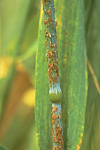
Figure 1 |
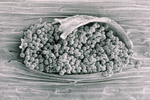
Figure 2 |
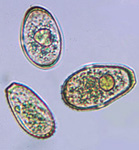
Figure 3 |
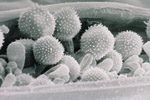
Figure 4 |
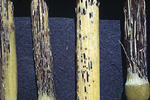
Figure 5 |

Figure 6 |
On barberry and other alternate hosts:
Pycnia appear on barberry plants (Figure 7) in the spring, usually in the upper leaf surfaces. They are often in small clusters and exude pycniospores in a sticky honeydew (Figure 8). Five to 10 days later, cup-shaped structures filled with orange-yellow, powdery aeciospores break through the lower leaf surface (Figure 9). The aecial cups are yellow and sometimes elongate to extend up to 5 mm from the leaf surface (Figure 10). Microscopically, aeciospores have a slightly warty surface (Figure 11).
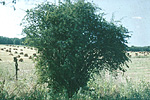
Figure 7 |

Figure 8 |
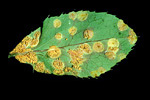
Figure 9 |

Figure 10 |

Figure 11 |
Pathogen Biology
Rust fungi are obligate parasites. In nature, they require living host tissue for growth and reproduction; they cannot exist as saprophytes. In the absence of living host tissue, they survive as spores. In most rust fungi, only the teliospores are adapted to survive apart from a living host plant for more than a few months under field conditions.
Puccinia graminis is heteroecious. This word describes rust fungi that require two unrelated host plants, such as wheat and barberry, to complete their life cycle. Puccinia graminis is macrocyclic, producing all five spore stages: basidiospores, pycniospores (spermatia), aeciospores, urediniospores (uredospores), and teliospores. Anton deBary, in 1865, first recognized the nature of the heteroecious life cycle, but the role of each spore stage was not completely understood until John Craigie, a Canadian scientist, studied the pathogen in 1927.
Although stem rust is caused by a single species of fungus, Puccinia graminis, there is considerable genetic variation within the species. In 1884, Eriksson discovered host-specific subspecies or "special forms" of the fungus. Each special form is designated in Latin as a forma specialis or "f. sp." All of the formae speciales have an identical appearance, but vary in host range. The pathogen that causes stem rust of wheat (Triticum aestivum) is Puccinia graminis f. sp. tritici. Other formae speciales include P. graminis f.sp. secalis, causal agent of stem rust of rye (Secale cereale), and P. graminis f.sp. avenae, causal agent of stem rust of oat (Avena sativa). Both Puccinia graminis f. sp. tritici and P. graminis f.sp. secalis cause stem rust in barley. About 1916, E.C. Stakman and others determined that within P. graminis f.sp. tritici are further genetic subdivisions called races. Later, races were found within other formae speciales as well.
Disease Cycle and Epidemiology
The disease cycle of wheat stem rust starts with the exposure of each new wheat crop to spores of Puccinia graminis f. sp. tritici, which are the primary inoculum. The source of the first spores that infect the new wheat crop differs depending on the region in which the wheat is grown. In warm climates, wheat is planted in late fall and harvested in early summer. The first spores to infect the young wheat plants in the fall are urediniospores. They generally come from infected volunteer wheat plants. Seed spilled in the field or on roadsides at harvest time often sprout and produce scattered volunteer plants. These plants can become infected from spores produced on late-maturing wheat plants still in the field. The infected volunteer wheat plants serve as a bridge that carries P. graminis f. sp. tritici through the summer to the next fall-sown crop of wheat.
In regions with temperate climates, wheat may be planted either in the fall (winter wheat) or the spring (spring wheat) depending on the severity of the winters (Figure 12). For example, few winter wheat varieties can survive well through the severe winters of Minnesota, North Dakota, and Manitoba, so most of the wheat grown there is spring wheat. The first rust spores to infect wheat in the spring in temperate regions may be aeciospores from barberry, the alternate host, or urediniospores from infected wheat in distant regions with milder winters. Therefore, we describe two disease cycles for stem rust - with or without barberry.

Figure 12-map6a |

Figure 12-map6b |

Figure 12-map7a |

Figure 12-map7b |
Disease cycle, with barberry
Barberry is the most dangerous source of primary inoculum of stem rust in temperate regions. If barberry grows near wheat fields, it will be a consistent source of aeciospores for the earliest infections of wheat in the spring (Figure 13).

Figure 5 |

Figure 13 |
Puccinia graminis overwinters as black, thick-walled, diploid teliospores that are produced on wheat or other grass hosts toward the end of the growing season (Figure 5). Karyogamy (fusion of two haploid nuclei to form a diploid nucleus) and meiosis (reduction division to produce four haploid basidiospores) take place in the teliospore. Teliospores are produced in a telium.
In the spring, each teliospore germinates to produce thin-walled, colorless, haploid basidiospores (Figure 14). Basidiospores infect the alternate hosts such as common barberry.
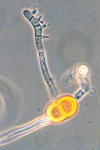
Figure 14 |
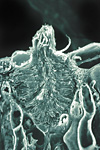
Figure 15 |
Basidiospores germinate and produce a haploid mycelium which colonizes the leaf tissue. From this mycelium, pycnia are formed inside the leaf but with the tops extending through the surface, usually in the upper surface, of barberry leaves. Pycnia produce receptive hyphae and pycniospores (Figure 15). No further development will occur until the receptive hyphae in the pycnium are fertilized by pycniospores from a pycnium of a different mating type. Pycnia and pycniospores are referred to as spermagonia and spermatia by some authors, but the former are the preferred terms of rust specialists.
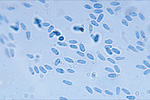
Figure 16 |

Figure 8 |
Pycniospores (Figure 16) are produced in a sticky honeydew that is attractive to insects and helps ensure that successful cross-fertilization occurs (figure 8). Insects carry pycniospores from one pycnium to another as they forage across the leaves feeding on the honeydew. Splashing raindrops also disperse pycniospores and aid in cross-fertilization. Fertilization of pycnia is critical in the rust fungus life cycle, because it gives rise to the dikaryotic mycelium. After the nucleus of the pycniospore joins that of the receptive hypha, the paired, haploid nuclei divide in tandem in the mycelium throughout the remaining stages of the life cycle. All stem rust infections of wheat or other grasses involve dikaryotic spores and dikaryotic mycelium.
Over a period of days, the dikaryotic mycelium grows through the barberry leaf until a new structure, the aecium, breaks through the lower surface of the leaf to release the dikaryotic aeciospores (Figure 10). Aeciospores, although produced on barberry plants, can infect only wheat or other grass host of P. graminis. Aeciospores (Figure 11) differ from urediniospores, which also infect wheat, in their appearance - slightly warty rather than spiny - and in the way in which they are formed - in chains in an aecium rather than on individual stalks in a uredinium.

Figure 10 |

Figure 11 |
On wheat, aeciospores germinate, the germ tubes penetrate into the plants, and the fungus grows as dikaryotic mycelium. Within 1 to 2 weeks, the mycelium in each infection produces a uredinium filled with brick-red, spiny, dikaryotic urediniospores that break through the leaf or stem epidermis (Figure 1).

Figure 1 |
In heteroecious rusts, this important spore stage is called the "repeating stage," because urediniospores are the only rust spores that can infect the host plant on which they are produced. Under favorable environmental conditions, multiple, repeated infections of the same wheat plant and neighboring wheat plants can result in explosive epidemics.

Figure 5 |

Figure 6 |
Toward the end of the growing season, black overwintering teliospores are formed in telia (Figure 5), and the life cycle is completed. Because karyogamy and meiosis take place in the teliospore (Figure 6), this spore stage is an important source of genetic recombination in addition to its role as a survival spore.
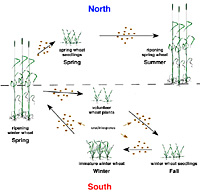
Figure 17 |
Disease cycle, without barberry
In North America, stem rust epidemics can occur in temperate regions even if barberry is not present (Figure 17). In the absence of barberry, the first spores of P. graminis to reach wheat in the spring are windborne urediniospores produced on winter wheat crops to the south (Figure 18). The mild climate along the coast of the Gulf of Mexico allows P. graminis to survive and spread in fields of winter wheat. Prevailing southerly winds in the spring carry the urediniospores north into the central Great Plains where they infect other winter wheat plants. Weather in the central Great Plains is usually too cold to permit stem rust infections during the winter. When spring wheat begins to grow in the northern Great Plains, it may be infected by windborne urediniospores from either the central or southern Great Plains. The stem rust disease cycle in the North ends with the wheat harvest.

Figure 18 |
In the South, the stem rust disease cycle starts with urediniospores that infect winter wheat seedlings after the fall planting. Most, if not all, of the primary inoculum is local. It comes from volunteer wheat plants that sprouted and became infected in the summer. Spread of urediniospores from north to south is not likely to be important. Spring wheat in the North is harvested in August, long before the new winter wheat crop has emerged in the South, where planting may not start until October or later. Barberry plants do not become infected in the South, so they are not a factor in stem rust epidemics there. This is because P. graminis teliospores will not germinate unless exposed to extended periods of freezing temperatures.
Epidemiology
Stem rust is favored by hot days (25-30ºC/ 77-86ºF), mild nights (15-20ºC/ 59-68ºF), and wet leaves from rain or dew. Both aeciospores and urediniospores require free water for germination as do the other spore stages. Infections occur through stomata.

Figure 13 |
The source of inoculum can be predicted from the pattern of the rust disease. If inoculum comes from barberry, a point source, the resulting disease pattern is usually fan-shaped with the alternate host at the apex of the fan (Figure 13). If disease has a more uniform pattern, the inoculum source is usually from a broad area, such as the southern wheat crops (in the northern hemisphere) from which urediniospores are released. Scattered infections mainly on the top leaves in a wheat field indicate that airborne spores were carried into the field from an external source. Rainfall is important for spore deposition during long distance dispersal of the spores.
If disease develops in individual foci within a wheat field, the source of urediniospores is probably overwintering mycelia and/or uredinia. Rusted plants in foci from overwintering sources have heavy infection in lower leaves and less infection in the younger leaves formed higher on the wheat plants.
In the absence of barberry or other alternate hosts, urediniospores are the only functional spores in the disease cycle of P. graminis. In tropical and subtropical climates, mycelium and urediniospores on volunteer wheat and noncrop grass hosts begin epidemics. Urediniospores are generally unable to survive harsh winter conditions. In the Northern Hemisphere, inoculum for spring wheat arrives from southern areas. In the Southern Hemisphere, urediniospores arrive from milder areas in the north. Occasionally, P. graminis can overwinter in wheat volunteers, noncrop grass hosts, and winter wheat, but usually only where snow cover insulates both the wheat leaves and the fungal mycelium. This is most likely to occur where winter wheat is planted directly into wheat stubble from the previous crop.
Urediniospores are produced approximately 7 to 15 days after infection, so there can be multiple generations of inoculum produced during a single growing season. One uredinium can produce at least 100,000 urediniospores. Explosive epidemics can occur during favorable environmental conditions, resulting in losses of 50 to 70% over a region.
Stem rust causes cereal yield losses in several ways. The fungus absorbs nutrients from the plant tissues that would be used for grain development in a healthy plant. As pustules break through the epidermal tissue, it becomes difficult for the plant to control transpiration, so its metabolism becomes less efficient. Desiccation or infection by other fungi and bacteria also can occur. Interference with the vascular tissues results in shriveled grains. Stem rust also can weaken wheat stems, so plants lodge, or fall over, in heavy winds and rain (Figure 19). Where severe lodging occurs, crops cannot be mechanically harvested.

Figure 19 |
Disease Management
Barberry eradication:
Once the life cycle of P. graminis was determined, the potential effects of the removal of the barberry alternate host became clear (Figures 20, 21). An expensive and extensive barberry survey (Figure 22) and eradication program was initiated in 1918 in the U.S. (Figure 23) and continues to a limited extent today (Figure 24).
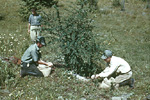
Figure 20 |
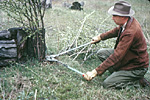
Figure 21 |

Figure 22 |

Figure 23 |

Figure 24 |

Figure 25 |
It was originally hoped that the program would eliminate stem rust as a significant disease in North America, because the basidiospores would have no barberry hosts to infect, and urediniospores could not usually survive harsh winter conditions. The importance of continental spread of stem rust epidemics was not understood until later. Urediniospores overwinter in wheat fields in the southern U.S. and northern Mexico and are then airborne northward via what is now called the "Puccinia Pathway" (Figure 25). If the weather is favorable for stem rust development in the South, urediniospores will arrive in time and in sufficient numbers to cause epidemics in northern wheat-growing areas.
Despite this problem, barberry eradication has had significant positive effects on the control of stem rust epidemics. First, it removed a significant, early source of inoculum. A single barberry plant can produce as many as 64 billion aeciospores. Second, it reduced the genetic variation in the fungal population by eliminating the sexual cycle, leaving only asexual urediniospores to maintain the fungus. Mutation is now the primary source of genetic variation. Consequently, there are no longer so many different races of wheat stem rust against which wheat breeders must seek resistance. Finally, epidemics are delayed by several weeks in many of the major wheat producing areas of the U.S. and Canada because aeciospores were released before the first arrival of urediniospores from the south.
Cultural practices
It has long been known that moisture on leaves and excessive foliar nitrogen favor infections by rust fungi. Farmers consider these factors in spacing, row orientation, and fertilizer schedules. Recent changes in production practices may have effects on stem rust. In some areas, summer wheat crops are irrigated, which may increase the survival of infected volunteer plants. In addition, many farmers are practicing no-till or minimum tillage. This increases the probability that rust fungi may successfully overwinter in the protective layer of stubble from the previous crop.
Use of earlier-maturing wheat varieties in the central Great Plains of the U.S. has helped reduce the threat of stem rust epidemics. Modern wheat varieties in that region mature about 2 weeks earlier than older varieties. This limits the length of time for stem rust epidemics to develop in the central Great Plains as well as the numbers of urediniospores that can contribute to epidemics farther north.
Genetic resistance
Genetic resistance is the most commonly used and the most effective means to control stem rust. Its success in North America is directly related to the reduced number of races present in the fungal population following the barberry eradication program. Because funding for the program has been reduced in recent years, scientists feared that the remaining barberry bushes will continue to spread into the wheat growing areas to serve both as a source of inoculum and as a means by which the fungus can complete its sexual cycle. Also, scientists realized that even in the absence of barberry, the currently used resistance genes should not be expected to remain effective indefinitely as new races of the fungus continue to arise by mutation. At least 50 distinct genes for race-specific (vertical) resistance to stem rust have been identified in wheat or transferred to wheat by wide crosses to wild relatives of wheat. Not all of these resistance genes are equally useful. Many were quickly discarded from wheat breeding programs, because virulent races that could overcome their resistance were found to be already prevalent in the fungus population. Others appeared to be widely effective when first used, but new virulent races of the fungus appeared within a few years of widespread use of the new resistance.
For reasons that we do not fully understand, a few genes for race-specific (vertical) resistance to stem rust in wheat remained highly effective for many years. The most successful of these was Sr31, a gene that occurs on a segment of a chromosome from rye that was transferred into wheat by a complicated process of interspecific hybridization. Wheat with Sr31 quickly became popular worldwide, because, in addition to Sr31, the rye chromosome segment also carried genes for increased grain yield as well as additional genes for resistance to other rust diseases. Since the 1980s, wheat varieties with Sr31 were widely grown in nearly every major wheat-producing region throughout the world other than Australia. The effectiveness of Sr31 was so great that wheat stem rust declined to almost insignificant levels nearly everywhere in the world by the mid-1990s.
Recently, the resistance of Sr31 was finally overcome. A new race of the wheat stem rust fungus highly virulent to wheat varieties with Sr31 was found in Uganda in 1999. The new race, tentatively designated Ug99, rapidly dominated the fungus population in Uganda and spread to Kenya and Ethiopia where it caused major epidemics. Within a few years, Ug99 was found in South Africa and in Yemen, from which it has spread to the north and east as far as Iran. It seems inevitable that Ug99 will soon invade one of the world's richest wheat producing areas in the Punjab of India. Previous examples of long distance dispersal of rust fungi include spread of a unique race of wheat stem rust from South Africa to Australia, spread of coffee rust from Africa to South America, and spread of southern corn rust from Central America to Africa. To make matters worse, the Ug99 lineage of the stem rust fungus has expanded its virulence through mutations that allow it to overcome the resistance of at least two other vertical resistance genes that wheat breeders have relied on for protection from stem rust in North America and many other parts of the world.
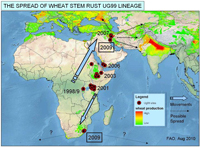
Figure 26 |
In response to the threat of impending wheat stem rust epidemics around the world, an international effort was organized in 2008 to reduce the vulnerability of the world's wheat crops to rust diseases. The organization, the Borlaug Global Rust Initiative, is coordinated by staff at Cornell University and includes research leaders from two international agricultural research centers, CIMMYT and ICARDA, the Food and Agriculture Organization of the United Nations, and the Agricultural Research Service of the U.S. Department of Agriculture. Primary efforts are concentrated on developing and deploying new effective resistance to wheat stem rust globally. Vertical resistance must be considered in the short term even though the durability of the resistance may be questionable. Combining two or more effective vertical resistance genes will provide a better chance for longer lasting resistance. For the long term, however, wheat breeders may rely more on minor genes with additive effects of partial resistance expressed primarily in adult plants (i.e., horizontal resistance). A number of high yielding wheat lines with moderate levels of horizontal resistance have already been developed at the International Center for Wheat and Maize Research (CIMMYT). These advanced lines are being intercrossed to produce improved wheat varieties combining as many as four or five horizontal resistance genes to effectively suppress stem rust epidemics. To preserve these effective combinations of horizontal resistance genes even when the Ug99 epidemics subside, it will be necessary to identify genetic markers for each of the genes so that breeders can continue to select for their presence even in the absence of disease.
Chemical control
In some areas where disease pressure is high, fungicides are applied to wheat to control rust diseases. Fungicides that inhibit the synthesis of sterols [i.e., sterol biosynthesis inhibitors (SBIs) or demethylation inhibitors (DMIs)] are particularly effective, but the cost of application is generally prohibitive for routine use in most wheat-growing areas in the U.S.
Potential approaches to management
Urediniospores infect wheat only through stomata. Scientists have studied how germinating urediniospores locate stomata on leaf surfaces (Figure 27). Although several factors are involved, the germ tube is able to detect the guard cells by their physical dimensions relative to the epidermal cells. Once a stoma is found, an appressorium is produced and infection begins. In the future, it may be possible to breed wheat resistant that is resistant to urediniospore infection because it has epidermal patterns that are not recognized by the fungus.
|
| 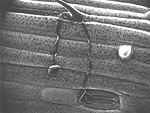
Figure 27 |
Historical Significance
Stem rust is one of the major diseases of wheat and barley and, therefore, a potential threat to the world food supply. Wheat is the largest food crop in the world, and barley is the sixth largest. Together, they account for more than 25% of the world food supply. It is estimated that more than $5 billion are lost to cereal rusts (leaf rust, stem rust, and stripe rust) each year. Cereal rusts have probably been a problem since the first cereal crops were grown in the Fertile Crescent. Spores of P. graminis have been found in archeological sites in Israel dating from 1300 B.C. Wheat, barley, and barberry all originated in the Fertile Crescent, so this complex relationship in the stem rust life cycle has an ancient history.
Wheat stem rust was a serious problem in ancient Greece and Rome. Rust was observed and recognized as early as the time of Aristotle (384-322 B.C.). The ancient Romans sacrificed red animals such as dogs, foxes, and cows to the rust god, Robigo or Robigus, each spring during the festival called the Robigalia in hopes that the wheat crop would be spared from the ravages of the rust (Figure 28). This festival was incorporated into the early Christian calendar as St. Mark's Day or Rogation on April 25. Historical weather records suggest that a series of rainy years, in which rust would have been more severe and wheat harvests reduced, may have contributed to the fall of the Roman Empire.
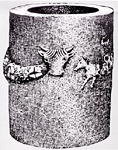
Figure 28 |
Although the parasitic nature of stem rust was not known until the 1700s, farmers in Europe had recognized much earlier that barberry was somehow connected to stem rust epidemics in wheat. Laws banning the planting of barberry near wheat fields were first passed in Rouen, France, in 1660.
The Italian scientists Fontana and Tozzetti independently provided the first detailed descriptions of the stem rust fungus in wheat in 1767. Persoon named it Puccinia graminis in 1797. By 1854, the Tulasne brothers recognized that some autoecious (single host) rust fungi could produce as many as five spore stages. They were the first to link the red (urediniospore) and black (teliospore) stages as different spores of the same organism, but the remaining stages of P. graminis remained a mystery.
Anton deBary was puzzled by the lack of infection when basidiospores of P. graminis were placed on wheat plants. Using the farmers' belief that barberries increased wheat rust, he successfully inoculated barberries with the basidiospores and observed the remaining spore stages develop on the alternate host. Once the heteroecious nature of the life cycle was established, many other known rust fungi were discovered to be heteroecious, and their hosts could be paired up.
Both wheat and barberry plants were brought to North America by the European colonists. Barberry has a number of practical uses including a yellow dye from the bark, jams and wines from the berries, tool handles from the wood, and fast-growing, thorny hedges to help retain animals. As in Europe, farmers began to recognize the connection between barberry and stem rust epidemics in wheat. Barberry laws were enacted in several New England colonies in the mid-1700s. However, barberry continued to spread as pioneer farmers moved west. From farmyard plantings, barberry spread into fencerows and woodlots. Barberry bushes can be 3 m (9 ft) high and produce abundant berries that are attractive to birds and animals that feed on them and spread their seeds.

Figure 22 |
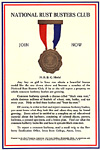
Figure 29 |
After the devastating 1916 North American stem rust epidemic, a cooperative state and federal barberry eradication program was established in 1918 (Figure 22). This program was partially motivated by the concern about food supplies during war. A "war against barberries" was established that enlisted help from the general population through radio and newspaper ads, extension pamphlets, and booths at fairs urging them to aid in the destruction of barberries. Even school children were encouraged to help find sites where barberry bushes existed (Figure 29). From 1975 through 1980, the program was gradually returned to the jurisdictions of various states. A federal quarantine is still maintained against sale of stem rust-susceptible barberry in states that were part of the barberry eradication program. A barberry testing program was established to ensure that only barberry species and varieties, such as the popular ornamental Japanese barberry, that are immune to stem rust will be grown in the quarantine area.
Selected References
USDA-ARS Cereal Disease Lab Website: Home page: http://www.ars.usda.gov/main/site_main.htm?modecode=36-40-05-00
Black Stem Rust Biology and Threat to Wheat Growers (from a presentation to the Central Plant Board Meeting February 5-8, 2001, Lexington, KY). Cereal Disease Laboratory website, University of Minnesota.
Introduction to cereal rusts: http://www.ars.usda.gov/Main/docs.htm?docid=9854
Barberry information: http://www.ars.usda.gov/Main/docs.htm?docid=9747
Bushnell, W.R. and A.P. Roelfs, 1984. The Cereal Rusts. Vol. 1. Origins, Specificity, Structure, and Physiology. Academic Press, Orlando.
Carefoot, G.L. and E.R. Sprott, 1967. Famine on the Wind. Rand McNally and Co., Chicago.
Cook, R.J. and R.J. Veseth, 1991. Wheat Health Management. American Phytopathological Society Press, St. Paul, MN.
Dubin, H.J. and S. Rajaram, 1996. Breeding disease-resistant wheats for tropical highlands and lowlands. Annual Review of Phytopathology 34:503-526.
Large, E.C. 1940. Advance of the Fungi. Dover Publications, New York.
Leonard, K.J. and L.J. Szabo. 2005. Stem rust of small grains and grasses caused by Puccinia graminis. Molecular Plant Pathology 6:99-111.
Littlefield, L.J. 1981. Biology of the Plant Rusts: An Introduction. Iowa State University Press, Ames.
McIntosh, R.A. and G.N. Brown, 1997. Anticipatory breeding for resistance to rust diseases in wheat. Annual Review of Phytopathology 35:311-326.
Peterson, P.D. (ed.) 2001. Stem Rust of Wheat: From Ancient Enemy to Modern Foe. APS Press. St. Paul, MN.
Roelfs, A.P. 1982. Effects of barberry eradication on stem rust in the United States. Plant Disease 66:177-181.
Roelfs, A.P. 1989. Epidemiology of the cereal rusts in North America. Canadian Journal of Plant Pathology 11:86-90.
Roelfs, A.P., and W.R. Bushnell, 1985. The Cereal Rusts. Vol. 2. Diseases, Distribution, Epidemiology, and Control. Academic Press, Orlando.
Roelfs, A.P., R.P. Singh, and E.E. Saari, 1992. Rust Diseases of Wheat: Concepts and Methods of Disease Management. CIMMYT, Mexico, D.F.
Ug99 References
Borlaug Global Rust Initiative: http://www.globalrust.org/
FAO website on the spread of race Ug99: http://www.fao.org/agriculture/crops/rust/stem/rust-report/stem-ug99racettksk/en/
Singh, R.P., D.P. Hodson, J. Huerta-Espino, Y. Jin, P. Njau, R. Wanyera, S.A. Herrera-Foessel, and R.W. Ward. 2008. Will stem rust destroy the world's wheat crop? Advances in Agronomy 98:272-309. (a pdf file of this reference can be found at http://ddr.nal.usda.gov/bitstream/10113/36520/1/IND44295123.pdf
Stone, M. 2010. Virulent new strains of rust fungus endanger world wheat. Microbe 5:423-428.http://www.microbemagazine.org/index.php/09-2010-home/2849-virulent-new-strains-of-rust-fungus-endanger-world-wheat
